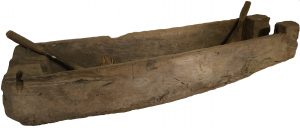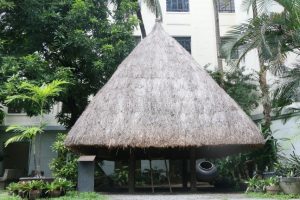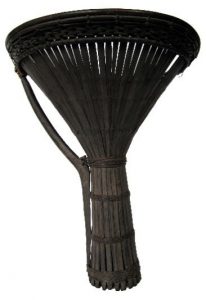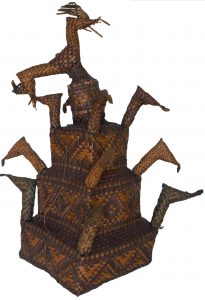RICE, BIODIVERSITY and CLIMATE CHANGE
Rice (Oryza sativa Linneaus) persists as the primary crop of Asia. One probable reason is its high productivity – which is essentially a type of grass – in this particular environment, although it is well-distributed in the tropics across the world. Local terms for ‘eating’ is synonymous to ‘eating rice,’ particularly in the south, southeastern and eastern regions of the continent. Many Asian communities have been founded on rice production, which may be the probable foundations for their deep cultural traditions on rice. Similar regard and importance on rice has also been observed and practiced in the Philippines. The exhibition was opened in 2013 as part of the celebration of the National Year of Rice for the Philippines led by the Philippine Rice Research Institute (PhilRice) and the Department of Agriculture (DA) and was supported by Senator Loren Legarda, Chairperson of the Senate Committee in Climate Change. The exhibition features collections of and on rice from the NM and PhilRice evoking its significance in the Filipino culture, in terms of science, traditional knowledge and heritage systems. It aims to support the country’s continuing campaign for the Philippines to be self-reliant on rice through responsible rice consumption and to recognize the other starch staples available in the country, such as banana, sweet potato, cassava, corn and unaw. Mortar and Pestle Panaltagan and A’lo Provenance: Pangasinan Physical Description: wood Measurements: Mortar, L 269cm W 64.0 cm H 54.0 cm; Pestles, L 92.5 to 98.0cm cm W 7.0 cm Catalog Number: Mortar, E-PANG-076 and Pestles, E-PANG-073 and E-PANG-075 Location: Rice, Biodiversity and Climate Change Gallery, 4F National Museum of Anthropology Key words: mortar, pestle, rice, grains, agriculture, household, Pangasinan, Ifugao, Cordillera Related publication: Conklin, Harold. C. 1980. Ethnographic Atlas of Ifugao: A Study of Environment, Culture, and Society in Northern Luzon. Yale University Press. Brief Description Mortar and pestle are used to pound rice, grains, and root crops. The common way of pounding rice is to loosen the grain/head from the stalk/straw on a dried carabao hide through the use of a pestle. The separated heads are gathered and transferred to the mortar and pounded again and again with a pestle until the grain is separated from the chaff. Stories from the collection Mortars are usually barrel-shaped and made of hardwood but some are made of concrete or limestone while pestles are made of wood and carved thinly at the middle to make it easy to grip with two hands. In other groups, mortars are in the form of a boat such as the mortar in Pangasinan and Palawan. In Pangasinan, pounding rice is done by the community which makes it possible because of its boat-shaped body. The locals pick enough dried stalk from the rice paddy enough for several meals and are stored in the granary-house lofts. They separate the grains from the panicles by hand, put the grain-laden into the mortar, then repeatedly pound and winnow the grains to separate the rice from the chaff ready for cooking. In Ifugao, both men and women do the pounding during ceremonies and special gatherings but for everyday consumption, women usually do the pounding and winnowing. When not in use, mortars are positioned upside-down and used as chair or chopping board. Every household normally own at least a pair of mortar and pestle which play significant role in the social and economic aspects of each household. Mortars are also incorporated as designs in the textiles of the different groups in the Cordillera manifesting its importance in the community. Ifugao House Bale/Fale Provenance: Mayaoyao, Ifugao Date Collected/Created: 1998 Physical Description: Wood, cogon (Imperata cylindrica) grass Measurements: L 575.0 cm W 480.0 cm H 576.0 cm Location: Rice, Biodiversity and Climate Change Gallery, 4F National Museum of Anthropology Key words: Ifugao House, granary, architecture, Ayangan, Mayoyao, Ifugao Related publication: Perez, R. D. III. 1989. Folk Architecture. GCF Books. UNESCO (United Nations Educational, Scientific and Cultural Organization). Ifugao Traditional Houses: A Glimpse on the Material Cultural Heritage of the Ifugao Rice Terraces. Retrieved from https://fmds.upou.edu.ph/index.php/publicservice?layout=edit&id=519. Brief Description The bale (Ayangan or Ifugao house) is a multi-functional one-room shelter where the entire family lives, sleeps, cooks, and eats. It is a well-built house that could withstand the changes in the environment which makes it fit for both the dry and wet seasons in the Philippines. The roof is thatched with cogon (Imperata cylindrica) grass. Its four sturdy posts are made of hardwood. The structure is made of timber and fixed without using iron nails. Stories from the collection The Ifugao house has an attic where harvested dried rice stalks are stored. For some families, they build a smaller version of the bale used as granary and is situated behind their house. It is also used as a chamber for religious practices and other ceremonies. The space underneath the house serves as shade and can be used for different activities such as rituals that involve the community. Underneath the house’s flooring, there are hooks or pegs on wooden beams which are used to hang baskets, chicken coops, spears and other things hung outside. There are many varieties on the architecture of the Ifugao house based on the different Ifugao sub-groups. This particular house belongs to the Ayangan sub-group from Mayoyao, Ifugao. Locust basket Provenance: Bontok, Mountain Province Date Collected/Created: 1978 Collected by: Bato Balani Art Center Physical Description: Bamboo, rattan, nito Measurements: H 57.0 cm D 13.0 cm (base) to 47.0 cm (opening) Location: Rice, Biodiversity and Climate Change Gallery, 4F National Museum of Anthropology Catalog Number: E-BON-361 Key words: locust, basket, pest, agriculture, Bontoc, Mountain Province Brief Description A funnel-shaped locust basket made of bamboo (Bambusoideae), rattan (Calamus), nito (Lygodium scandens) and wooden side handle. This is used to catch locusts from the farmland by the Bontoc people in the Mountain Province. Locusts are pests to agriculture as they can form in high densities and easily destroy fields. Stories from the collection The funnel shape of this locust basket makes it easier to catch a swarm of locusts because of its wide rim and narrow throat where the locusts are trapped. The locusts are stored in another basket and cooked and consumed by the locals as another source of food. Rice granary god/idol Bulol / bulul Provenance: Ifugao, Cordillera Physical Description: Ifugao, Cordillera Measurements: L 37.0 cm W 10.0 cm H 13.0 cm Catalog Number: E-IFU-883 Location: Rice, Biodiversity and Climate Change Gallery, 4F National Museum of Anthropology Key words: rice, granary, ritual, Ifugao Related publications: Anderson, E. M. 2010. In the Shape of Tradition: Indigenous Art of the Northern Philippines. The Hague: C. Zwartenkot Art Books – Leiden. Benitez-Johannot, P. 2007. Rice Granary Deity. In Musée Barbier-Mueller and Hazan (eds.), Arts of Africa and Oceania, p. 274. Switzerland: Musée Barbier-Mueller. URL: http://www.barbier-mueller.ch/collections/mers-du-sud/sculptures-des-mers-du-sud/article/rice-granary-deity?lang=en. Accessed November 2016. Casiño, E. S. 1973. Ethnographic Art of the Philippines: An Anthropological Approach. Quezon City: Bookman Print House. Ellis, G. R. 1981. “Arts and People of Northern Philippines.” In G. Casal, R. T. Jose Jr., E. S. Casiño and E. R. Ellis (eds.), The People and Art of the Philippines, pp. 183-263. Los Angeles: Museum of Cultural History, University of California. Peralta, Jesus. T. 1977. “Wooden Gods and other Carvings.” In A. R. Roces editor-in-chief, The Metal Age in the Philippines: Foundations of the Society, Vol. 2, pp. 455-460. Lahing Pilipino Publishing Inc. Roxas-Lim, A. 1973. Art in Ifugao Society. Asian Studies 11 (2): 47-74. Brief Description The bulol / bulul is a wooden figure prominent in the areas of Northern Luzon particularly in Ifugao. It plays an important role in agriculture as it serves as their guardian for their rice granaries. The positions and expressions of the bulul have different meanings and descriptions focusing mainly on religious and economic causes. Aside from being a deity for rice, it is also sometimes used as a symbol of fertility and also believed to house spirits of their ancestors. Stories from the collection The granary deities or bulul / bulol / bu-lul / bullul / nabulul in northern Luzon are anthropomorphic woodcarvings central to the Ifugao rice culture. The bulul, usually a pair of male and female human figures carved in standing or squatting position with both arms outstretched, folded, overlapped or crossed, are installed inside the rice granary to protect against pests and ensure abundance of rice. Rice spirits are invoked by the ritual priests (mumbaki) to dwell into the wooden idols during harvesting rituals for a bountiful rice harvest. Bulul is also found in ceremonies for constructing a new rice granary or new house for a married couple, exhumation or re-interment of ancestral bones and recovery of a sick family member. Rice Container Minarigay

Mortar and pestle are used to pound rice, grains, and root crops. The common way of pounding rice is to loosen the grain/head from the stalk/straw on a dried carabao hide through the use of a pestle. The separated heads are gathered and transferred to the mortar and pounded again and again with a pestle until the grain is separated from the chaff.
Mortars are usually barrel-shaped and made of hardwood but some are made of concrete or limestone while pestles are made of wood and carved thinly at the middle to make it easy to grip with two hands. In other groups, mortars are in the form of a boat such as the mortar in Pangasinan and Palawan.
In Pangasinan, pounding rice is done by the community which makes it possible because of its boat-shaped body. The locals pick enough dried stalk from the rice paddy enough for several meals and are stored in the granary-house lofts. They separate the grains from the panicles by hand, put the grain-laden into the mortar, then repeatedly pound and winnow the grains to separate the rice from the chaff ready for cooking. In Ifugao, both men and women do the pounding during ceremonies and special gatherings but for everyday consumption, women usually do the pounding and winnowing. When not in use, mortars are positioned upside-down and used as chair or chopping board. Every household normally own at least a pair of mortar and pestle which play significant role in the social and economic aspects of each household. Mortars are also incorporated as designs in the textiles of the different groups in the Cordillera manifesting its importance in the community.

The bale (Ayangan or Ifugao house) is a multi-functional one-room shelter where the entire family lives, sleeps, cooks, and eats. It is a well-built house that could withstand the changes in the environment which makes it fit for both the dry and wet seasons in the Philippines. The roof is thatched with cogon (Imperata cylindrica) grass. Its four sturdy posts are made of hardwood. The structure is made of timber and fixed without using iron nails.
The Ifugao house has an attic where harvested dried rice stalks are stored. For some families, they build a smaller version of the bale used as granary and is situated behind their house. It is also used as a chamber for religious practices and other ceremonies. The space underneath the house serves as shade and can be used for different activities such as rituals that involve the community. Underneath the house’s flooring, there are hooks or pegs on wooden beams which are used to hang baskets, chicken coops, spears and other things hung outside. There are many varieties on the architecture of the Ifugao house based on the different Ifugao sub-groups. This particular house belongs to the Ayangan sub-group from Mayoyao, Ifugao.

A funnel-shaped locust basket made of bamboo (Bambusoideae), rattan (Calamus), nito (Lygodium scandens) and wooden side handle. This is used to catch locusts from the farmland by the Bontoc people in the Mountain Province. Locusts are pests to agriculture as they can form in high densities and easily destroy fields.
The funnel shape of this locust basket makes it easier to catch a swarm of locusts because of its wide rim and narrow throat where the locusts are trapped. The locusts are stored in another basket and cooked and consumed by the locals as another source of food.

The bulol / bulul is a wooden figure prominent in the areas of Northern Luzon particularly in Ifugao. It plays an important role in agriculture as it serves as their guardian for their rice granaries. The positions and expressions of the bulul have different meanings and descriptions focusing mainly on religious and economic causes. Aside from being a deity for rice, it is also sometimes used as a symbol of fertility and also believed to house spirits of their ancestors.
The granary deities or bulul / bulol / bu-lul / bullul / nabulul in northern Luzon are anthropomorphic woodcarvings central to the Ifugao rice culture. The bulul, usually a pair of male and female human figures carved in standing or squatting position with both arms outstretched, folded, overlapped or crossed, are installed inside the rice granary to protect against pests and ensure abundance of rice. Rice spirits are invoked by the ritual priests (mumbaki) to dwell into the wooden idols during harvesting rituals for a bountiful rice harvest. Bulul is also found in ceremonies for constructing a new rice granary or new house for a married couple, exhumation or re-interment of ancestral bones and recovery of a sick family member.

Minarigay or marigay are woven dyed sesed (Fimbristylis miliacea) baskets shaped as towers, mosques, houses and sarimanok figures serving as receptacles for rice, sweets, money or other valuable gifts.
It is traditionally strung on a decorated frame suspended from a tree, holding the prizes for the sipa manggis game (Szanton 1963).
inquiry@nationalmuseum.gov.ph
(+632) 8298-1100
